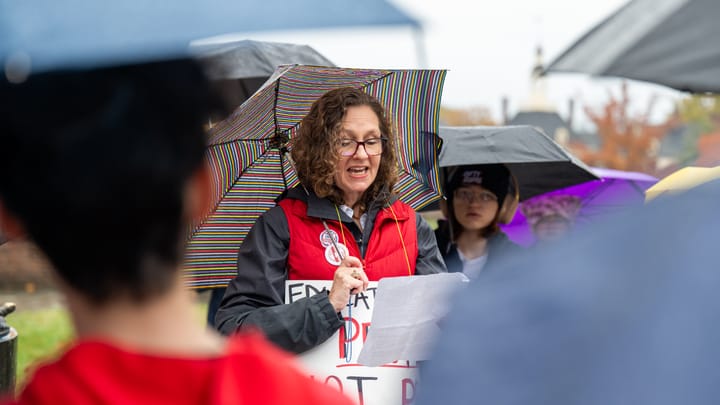Faculty share concerns as Miami 'rebrands' regional campuses
Miami University plans to begin shifting its regional campuses to focus on polytechnic education by fall 2026. Some faculty shared their concerns about straying away from the liberal arts.

Some Miami University shared their concerns with the Oxford Free Press about the university straying from its historical liberal arts foundation as plans to shift regional campuses to polytechnics unfold.
Since the fall 2023 semester, Miami has been pushing through its MiamiTHRIVE initiative, which has included creating a “Miami University Polytechnic Campus” as of President Gregory Crawford’s April 2 update. The campus, according to Crawford, would involve building on existing partnerships with Butler Tech and providing access to applied education, as originally reported by the Oxford Free Press in April.

This announcement came as the university continued work on its Advanced Manufacturing Hub near the Hamilton campus, which is due to open in January 2026. At the time, Ande Durojaiye, vice president for strategy and partnerships, told the Oxford Free Press Miami would likely rebrand parts of its regional campuses to make the polytechnic campus a reality.
During his Fall 2025 State of the University Address, Crawford again touched on the idea of a polytechnic-based education, this time referring to the Hamilton campus.
Now, Moira Casey, interim dean of the college of liberal arts and applied sciences and Miami University regionals, says a full rebrand of the regional campuses in Hamilton and Middletown and the Voice of America Learning Center in West Chester will be complete with a “soft launch” in the fall of 2026 and a new curriculum beginning in fall 2027.
“We have been experiencing declining enrollments at the regionals for some time, and (are) trying to think about economic sustainability for the regional campuses, but also about how we could better serve the local communities within which the regional campuses are situated,” Casey said of the decision to rebrand.
According to data on Miami’s Office of Institutional Research and Effectiveness website, headcount undergraduate enrollment at the Hamilton campus decreased by 200 students, from 2,451 to 2,251, between the fall 2020 and fall 2022 semesters – a more than 8% loss. But enrollment increased by 187 students, from 2,251 to 2,438, between the fall 2022 and fall 2024 semesters, or by more than 8%.
At the Middletown campus, undergraduate headcount enrollment has decreased over the past five years, between the fall 2020 and fall 2024 semesters, by 450 students, from 1,640 to 1,190, or a more than 27% loss.
Casey said polytechnics involve working closely with local industries to understand their talent pipelines and where they’re having trouble filling positions and “blur(ring) the boundaries between the classroom and the workplace.”
“When we thought about polytechnics in the THRIVE strategic planning process, we found that this was a real opportunity for the regional campuses to really redesign our programs, embed that applied learning throughout our curriculum and make sure that we are offering the programs that meet those workforce needs,” she said.
For example, Casey said Ohio has identified several areas where there’s a high demand for the workforce and not enough graduates, including in advanced manufacturing, computer and information technology, aerospace, healthcare and construction.
According to an industry employment outlook from the Ohio Bureau of Labor Market Information, between 2022 and 2032, service-providing industries – including those in wholesale trade, information, finance, real estate, professional and technical services – are expected to add the most jobs. Meanwhile, goods-producing industries – including agriculture, forestry, mining, oil and gas extraction, construction and manufacturing – are expected to see a decrease in jobs.
Overall, the health care and social assistance services industry is expected to add the most new jobs, according to the outlook.
Faculty respond
The Faculty Alliance of Miami (FAM) released a formal statement on Oct. 31, reacting to the restructuring of the regional campuses, titled “The Liberal Arts Are the Beating Heart of the Polytechnic.”
In the statement, FAM claims the decision to rebrand took faculty and students “by surprise” and was “hastily implemented through a two-month restructuring process that will radically transform our university and our students’ education.”
FAM said in its statement, it is not against change, but restructuring requires forethought and buy-in from stakeholders, as well as “doubling down” on the liberal arts education Miami has historically provided.
“All Miami students deserve a quality liberal arts education,” FAM wrote. “This is equally true for regional students who deserve new technical majors and degrees, yes, but alongside high-quality liberal arts majors and degrees – not as a replacement for them.”
FAM further demands in its statement the administration include a clearly stated commitment to the liberal arts and humanities in its rebrand of the regional campuses and give faculty a say in its departments and curriculum.
Cathy Wagner, a professor of English at Miami and member of FAM, said of the decision to rebrand the regional campuses, “This feels of a piece with a lot of other decisions that the university has made recently, in that it’s pretty top-down.”
“It doesn’t take into account the faculty and student perspectives, and it’s being implemented really hastily.”
Elena Jackson Albarrán, executive vice president of FAM and professor of history and global intercultural studies, said faculty affiliated with liberal arts departments have been approaching FAM looking for a “job security anchor” as they’re afraid their jobs may be rendered unnecessary with the brand shift.
She said the pace and direction of the rebranding is “concerning to everybody.”
Albarrán said she’s concerned the rebrand would also mark a “class-based” difference between the regionals and the main campus.
“Creating a curriculum assumes that people at the regionals are more and better suited for manual vocations and that (it) is somehow mutually exclusive of access to a broader liberal arts and especially humanities education is pretty fundamentally classist,” she said.
Overall, Albarrán said faculty are concerned about what the polytechnic shift means for Miami’s mission moving forward as majors across the university have been “streamlined” or restructured with what she sees as a focus going towards programs like nursing, data science and engineering.
In the ‘midst’ of research
When asked if the university has polled faculty, students or families at their regional campuses at any point to see if the polytechnic rebrand was something they wanted, Casey said “We’re in the midst of doing a lot of that research right now.”
“We work with the educational advisory board. We have a partnership with them as an institution, and they’re doing some market scans right now on the polytechnic,” she said, adding they’re also currently surveying students to understand how to communicate the polytechnic and strategic planning process.
“The THRIVE strategic plan out of which the polytechnic concept emerged really engaged with many, many, many people at Miami University,” she said.
Theresa Kulbaga, president of FAM and a professor of English on the Hamilton campus, said while it's true the university is currently gathering feedback on its decision to restructure the regional campuses, “We are concerned that our feedback won’t be listened to.”
“Many of us feel that we’re already doing workforce-focused education and don’t need restructuring,” Kulbaga said. “It really just seems like this is fast-tracking something that has already been decided.”
On keeping liberal arts programs
When asked if students will still be able to receive a liberal arts education from regional campuses, Casey said, “Right now we have a variety of programs here on the regional campuses, some of which you would categorize as liberal arts degrees. … If those programs are thriving and successful, we will keep them.”
Casey said some low-enrolled programs were sunsetted last year, but there are a couple more that may end after the current academic year, although she couldn’t yet disclose them.
Overall, she said the shift is in response to a “statewide need,” which the university is also attempting to combat by providing student housing on the regional campuses to “pull in” students from outside the immediate area. She said details are still being worked out for student housing, but it would ideally become a reality in fall 2028.
The regional campuses already offer applied learning courses, Casey said, but will now “lean into their strengths.”
For example, she said although the Hamilton campus has always had an engineering technology program, it’ll be expanded to create more pipelines for high school students to earn college credit, and curriculum will be adjusted to ensure it is “delivering what our workforce partners want.”
One company Miami is already working with is called Makino, which Casey said is donating some equipment to the advanced manufacturing hub. She said Miami is also in talks with Johnson & Johnson and Cintas, and organizations like Ohio Means Jobs will help to “meet the mission of the polytechnic.”




